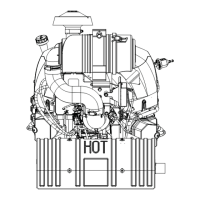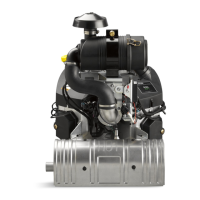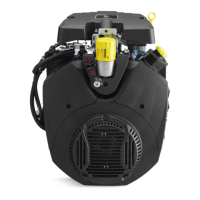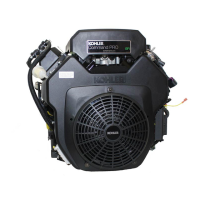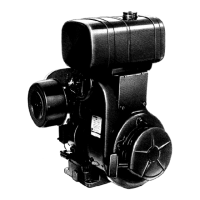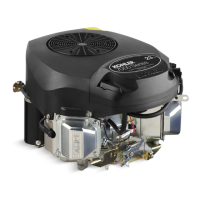2962 690 05 Rev. H KohlerEngines.com
EFI SYSTEM-ELECTRONIC THROTTLE BODY (ETB)
Purpose of sensing air temperature is to help ECU
calculate air density. Higher air temperature less dense
air becomes. As air becomes less dense ECU knows
that it needs to lessen fuel fl ow to achieve correct air/fuel
ratio. If fuel ratio was not changed engine would become
rich, possibly losing power and consuming more fuel.
Manifold Absolute Pressure check provides immediate
manifold pressure information to ECU. TMAP sensor
measures diff erence in pressure between outside
atmosphere and vacuum level inside intake manifold
and monitors pressure in manifold as primary means
of detecting load. Data is used to calculate air density
and determine engine's mass air fl ow rate, which in
turn determines required ideal fueling. MAP also stores
instant barometric pressure reading when key is turned
ON.
Oxygen sensor functions like a small battery, generating
a voltage signal to ECU based upon diff erence in oxygen
content between exhaust gas and ambient air.
Tip of sensor protrudes into exhaust gas. When oxygen
concentration on one side of tip is diff erent than that of
other side, a voltage signal up to 0.98 volt is generated
and sent to ECU. Voltage signal tells ECU if engine is
straying from ideal fuel mixture, and ECU then adjusts
injector pulse accordingly.
Oxygen sensor functions after being heated to a
minimum of 400°C (752°F). A heater inside sensor heats
electrode to optimum temperature in about 10 seconds.
Oxygen sensor receives ground through wire, eliminating
need for proper grounding through muffl er. If problems
indicate a bad oxygen sensor, check all connections and
wire harness. Oxygen sensor can also be contaminated
by leaded fuel, certain RTV and/or other silicone
compounds, fuel injector cleaners, etc. Use only those
products indicated as O2 Sensor Safe.
Fuel injectors mount into intake manifold, and high
pressure fuel line attaches to them at top end.
Replaceable O-rings on both ends of injector prevent
external fuel leakage and also insulate it from heat and
vibration. A special clip connects each injector to high
pressure fuel line and holds it in place. O-rings and
retaining clip must be replaced any time fuel injector is
separated from its normal mounting position.
When key switch is on, fuel pump module will pressurize
high pressure fuel line to 39 psi, and voltage is present
at injector. At proper instant, ECU completes ground
circuit, energizing injector. Valve needle in injector
is opened electromagnetically, and pressure in high
pressure fuel line forces fuel down through inside.
Director plate at tip of injector contains a series of
calibrated openings which directs fuel into manifold in a
cone-shaped spray pattern.
Injectors have sequential fueling that open and close
once every other crankshaft revolution. Amount of fuel
injected is controlled by ECU and determined by length
of time valve needle is held open, also referred to as
injection duration or pulse width. Time injector is open
(milliseconds) may vary in duration depending on speed
and load requirements of engine.
A high-voltage, solid-state, battery ignition system is
used with EFI system. ECU controls ignition output and
timing through transistorized control of primary current
delivered to coils. Based on input from crankshaft
position sensor, ECU determines correct fi ring point
for speed at which engine is running. At proper instant,
it interrupts fl ow of primary current in coil, causing
electromagnetic fl ux fi eld to collapse. Flux collapse
induces an instantaneous high voltage in coil secondary
which is strong enough to bridge gap on spark plug.
Each coil fi res every other revolution (during normal
running).
ETB EFI engines are equipped with either a 20 amp or
high output charging system to accommodate combined
electrical demands of ignition system and specifi c
application. Charging system troubleshooting information
is provided in Electrical System.
An electric fuel pump module and a lift pump are used
to transfer fuel in EFI system. Types of lift pumps are:
a pulse fuel pump, a mechanical fuel pump, or a low
pressure electric fuel pump. Pumping action is created
by either oscillation of positive and negative pressures
within crankcase through a hose, or by direct lever/pump
actuation off rocker arm movement. Pumping action
causes diaphragm on inside of pump to pull fuel in on its
downward stroke and to push it into fuel pump module
on its upward stroke. Internal check valves prevent fuel
from going backward through pump. Fuel pump module
receives fuel from lift pump, increases and regulates
pressure for fuel injectors.
Fuel pump module is rated for a minimum output of
13.5 liters (3.51 gallons) per hour and regulated at 270
kilopascals (39 psi).
When key switch is turned ON and all safety switch
requirements are met, ECU activates fuel pump module
for about six seconds, which pressurizes system for
start-up. If key switch is not promptly turned to start
position, engine fails to start, or engine is stopped with
key switch ON (as in case of an accident), ECU switches
off pump preventing continued delivery of fuel. In this
situation, MIL will go on, but it will go back off after 4
cranking revolutions if system function is OK. Once
engine is running, fuel pump remains on.
Precision components inside fuel pump module are not
serviceable. DO NOT attempt to open fuel pump module.
Damage to components will result and warranty will be
void. Because fuel pump module is not serviceable,
engines are equipped with a special 10-micron EFI fuel
fi lter to prevent harmful contamination from entering
module.
If there are two fi lters in system, one before lift pump
will be a standard 51-75 micron fi lter, and one after lift
pump will be special 10-micron fi lter. Be sure to use an
approved 10-micron fi lter for replacement.
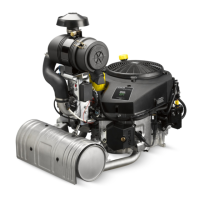
